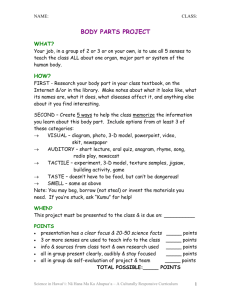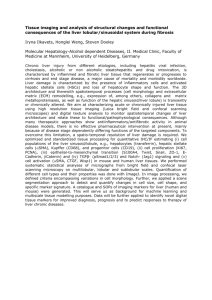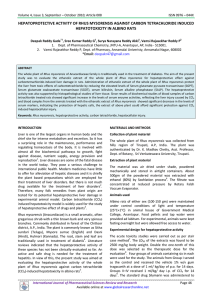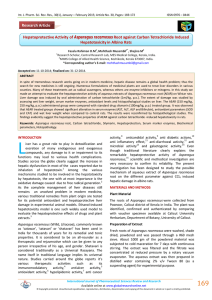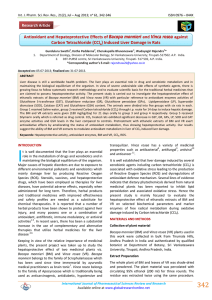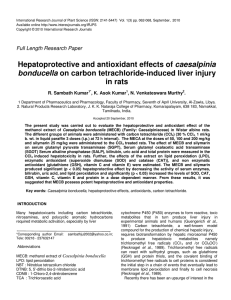Constituents ,Antibacterial and Antihyperlipidimic Activities of the
advertisement
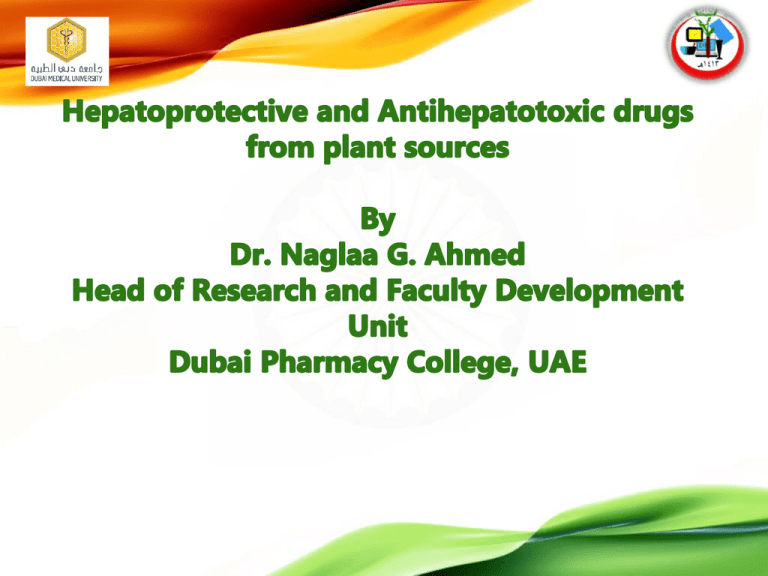
• Objectives • Introduction • Methods •Results & Discussion • Future Plan To discuss the important causes of liver injury. To recall some plants from different floras are highly reputed for their uses in folk and traditional medicine to control hepatotoxicity. To Evaluate the protective effect of some medicinal plants grown in UAE and Saudi on CCl4-induced hepatic damage in rats. To Evaluate the curative effect of the plants extracts on CCl4induced hepatic damage in rats. To find other effective hepatoprotective and antihepatotoxic herbal medicine from the Saudi and UAE floras • The liver is the body's largest and most important metabolic organ. • It serves as the major biochemical factory of the body. • • • • • • • Major functions of the liver Production of bile salts Synthesis of plasma proteins Metabolic processing of nutrients Removal of toxic or harmful substances from the blood Storage - Glycogen, fats, iron, copper and vitamins Vitamin D activation Excretion of cholesterol and bilirubin • Liver diseases are considered as one of the serious health problems. WHO ,130–150 million people globally have chronic hepatitis C infection. A significant number of those who are chronically infected will develop liver cirrhosis or liver cancer. 848,636people die each year from liver disease Every year approximately 695,200 people die due to liver cancer • A number of pharmacological and chemical agents act as hepatotoxins and produce a variety of liver ailments. • Drugs are an important cause of liver injury. • More than 900 drugs, toxins, and herbs have been reported to cause liver injury, and drugs account for 2040% of all instances of fulminant hepatic failure. Non-steroidal anti-inflammatory drugs, antihypertensives, antidiabetic agents, anticonvulsants, lipid-lowering agents, psychotropic drugs also recommended to become hepatoxic drugs Chitturi S and George J. Hepatotoxicity of commonly used drugs: nonsteroidal anti-inflammatory drugs, antihypertensives, antidiabetic agents, anticonvulsants, lipid-lowering agents, psychotropic drugs. S emin Liver Dis. 2002;22(2):169-83. • Steroids, vaccines and antiviral drugs which have been employed as a therapy for liver diseases, have potential adverse effects especially when administered for long terms. • In absence of reliable liver-protective drugs in modern medicine, hepatoprotective drugs from plant sources seem to be attractive alternative. Many plants of the Chinese, European, Arabic and Indian floras are highly reputed for their uses in folk and traditional medicine to control hepatotoxicity. Milk Thistle (Silybum marianum) • سلبين مريميMilk thistle has been used for over 2,000 years as a natural treatment for liver disorders. •Amazing herb protects the liver cells from damaging molecules called free radicals. •Milk thistle is often suggested as a treatment for alcoholic hepatitis and alcoholic cirrhosis. •Most studies show milk thistle improves liver function and increases survival in people with cirrhosis or chronic hepatitis. Agency for Healthcare Research and Quality. Milk thistle: effects on liver disease and cirrhosis and clinical adverse effects. Summary, evidence report/technology assessment: number 21, September 2000. Asghar Z, Masood Z. Evaluation of antioxidant properties of silymarin and its potential to inhibit peroxyl radicals in vitro. Pak J Pharm Sci. 2008 Jul;21(3):249-54. • Dandelion Root (Taraxacum officinale) طرخشقون • The bitter constituents in the root enhance liver function by increasing production of bile and improving gallbladder function. Choi UK1, Lee OH, Yim JH, Cho CW, Rhee YK, Lim SI, Kim YC. Int J Mol Sci. 2010 Jan 6;11(1):67-78. doi: 10.3390/ijms11010067 . Turmeric (Curcuma domastica) كركم • Turmeric's antioxidant properties protect the liver from numerous toxic chemicals. Turmeric has been reduced cancer-causing agents in the liver. •MOHSEN et al . Antioxidant and Free Radical Scavenging Activities of Curcumin. Asian Journal of Chemistry; Vol. 25, No. 13 (2013), 7593-7595. • Schisandra (Schisondra chinensis) • The plant protects the liver from damage by a variety of its antioxidant effects gradually improves overall health chronic stress is part of the life. • Cheng et al. Antioxidant and hepatoprotective effects of Schisandra chinensis pollen extract on CCl4-induced acute liver damage in mice , Food Chem Toxicol. 2013 • Date fruit can be considered as a rich source of antioxidant and hepatoprotective agent • Ebtesam et al. Phenolic Contents and Antioxidant Activity of Various Date Palm (Phoenix dactylifera L.) Fruits from Saudi Arabia Food and Nutrition Sciences, 2011, 2, 1134-1141 doi:10.4236/fns.2011.210152 Published Online December 2011 (http://www.SciRP.org/journal/fns) Methodology A. Plants material and extraction Ten Plants belonging to different families were collected from Western areas of Saudi Arabia and from Dubai (UAE) during March till May (2009-2014). The air-dried powdered plants (Arial parts) (500 g each) were separately macerated in ethanol then evaporated under reduced pressure by using rotary evaporator . The residues were kept at 4°C for the biological study. Cucumis prophetarum L. , Hypoestes forsskalei Chrozophora oblongifolia Capparis spinosa Cluytia myricoides Blepharis ciliaris (L.) Rumex nervosus Calotropis procera Fagonia indica Zygophylum hamience B. HPLC analysis of the phenolics • The phenolic compositions were investigated in aliquots (1 g, each) of the hydrolysed-methanolic extracts of the plants via RP-HPLC. • Analyses were carried out at operating conditions suitable for detection of either phenolic acids or flavonoids . Animals. Male Wister rats, weighing 140-180 g were used. All animals investigations were performed in accordance with the guidelines of the Biochemical and Research Ethical committee at the King Abdalaziz University, Jeddah, Saudi Arabia and Research Ethical Committee , Dubai Pharmacy College. Acute oral toxicity study : • LD50s of the alcoholic extracts of the plants under investigation were estimated to assess their safety (Lorke, 1983). Lorke, D., A new approach to practical acute toxicity testing.Arch Toxicol., 54, 275-387 (1983). Hepatoprotective effect Group # Type of rats treatment 1 Control Group liquid paraffin 2 CCl4 Without treatment 3 Positive Control Group standard silymarin (150 mg/kg in 1 % CMC-Na) 4-13 Treated Groups received the plants extracts in a dose of 500 mg/kg. The rats were received either silymarin or the different extracts by oral gavage once daily for 7 days before induction of liver injury by CCl4. Animals of groups 1 and 2 received 1 % CMC-Na once daily for 7 days. Liver injury was induced by subcutaneously (sc) injection of CCl4 in a dose of 35 μg/100 g diluted in liquid paraffin (0.3 ml/kg). Animals of all groups received CCl4 in liquid paraffin at day 8, except the control one. Twenty four hours, after injecting CCl4, blood samples were collected, plasma was separated by centrifugation at 3500 rpm and the liver enzymes namely ALT, AST and ALP activities were determined. • Sangameswaran B, Reddy TC, Jayakar B. Hepatoprotective effect of leaf extracts of Andrographis lineata nees on liver damage caused by carbon tetrachloride in rats. Phytotherapy research 2008; 22:124-126. Hepatotoxicity in Male Wister rats was induced by s.c. injection of CCl4 dissolved in liquid paraffin (30% solution), in a dose of 1 ml/kg b.w. for 4 weeks. Group # Type of rats Treatment 1 Control Group Liquid paraffin 2 3 4-13 Negative control Without treatment only received 1 % CMC-Na after 29 days Positive Control Group standard silymarin (150 mg/kg in 1 % CMC-Na) after 29 days by oral gavage Plants Groups received the plants extracts in a dose of 500 mg/kg after 29 days by oral gavage At the end of the experiment (8 weeks), blood samples were collected from the orbital sinus of each rat and plasma were separated by centrifugation at 3500 rpm. Plasma samples were kept under -20 ºC and were used for determination of the other parameters. Animals were anesthetized with diethyl ether and sacrificed by cervical dislocation for separation of the liver. Livers were dissected out, divided into two parts. One part was kept in liquid nitrogen for determination of • The other part was antioxidant status by immediately fixed in measuring the levels of buffered formalin 10% tissue contents of and was used for reduced glutathione (GSH), malondialdehyde histopathological (MDA), the enzyme studies. activities of superoxide dismutase (SOD), glutathione peroxidase (GPx), glutathione –Stransferase (GST) and glutathione reductase (GR). STATISTICAL ANALYSIS Data are expressed as mean ± standard error (SE) of mean. Unless otherwise indicated, statistical analyses were performed using one-way analysis of variance (ANOVA). If the overall F-value was found statistically significant (p<0.05), further comparisons among groups were made according post hoc Tuckey's test. All statistical analyses were performed using GraphPad InStat 3 (GraphPad Software, Inc. La Jolla, CA, USA) software. HPLC analysis of flavonoid and phenolic compounds of the different plants revealed that most of the plants showed high contents from phenolic compounds especially Quercetin, Quercetrin, rutin and Rosmarinic acid were detected in all plants under investigation. LD50 : Oral administration of the alcoholic extracts of different plants in doses up to about 4 g/kg body weight produced neither mortality nor signs of morbidity or behavioral changes in any of the treated animal groups under examination. This indicates the wide safety margin of our plants extracts. b b b b b b b b The values are expressed as the mean ± SE of the mean. a, Significantly different from the values of the normal rats at P<0.05. b, significantly different from the control values of CCl4 at P<0.05 a b b b b b b b Fig. 4: The effect of the plant extracts on hepatic lipid peroxidation levels and antioxidant enzymes activities in CCl4-induced hepatic damage in rats a b b b b b b The values are expressed as the mean ± SE of the mean of 8 rats, a, Significantly different from the values of the normal rats at p <0.05. b Significantly different from the control values of CCl4-induced hepatotoxic rats at p <0.05. • Fig.1: Histopathological examination of Liver sections from rats of the control group rats(A), rats treated with CCl4(B), silymarin + CCl4 (C) and extract of B. ciliaris + CCl4 (D) (H&E X 250) Fig.5: Histopathological examination of Liver sections from rats of the control group rats(A), rats treated with CCl4(B), silymarin + CCl4 (C) and extract of B. ciliaris + CCl4 (D) (H&E X 250) In our study, we are focusing on the liver damage which always accompanied by cellular necrosis, increased in tissue ALP and diminution of reduced liver glutathione. In addition, elevated levels of hepatic serum enzymes are indicative of cellular leakage. The hepatotoxic effect of CCl4 are related to its active metabolite trichloromethyl radical, •CCl3, this is observed by an elevation in the serum marker enzymes namely AST, ALT, ALP. Also these effects were coupled with a marked hepatic oxidative stress (decreased GSH, SOD, GPx, GR and GST activities in liver tissue and increased production of MDA activities in liver tissue). Muriel P, Escobar Y. Kupffer cells are responsible for liver cirrhosis induced by carbon tetrachloride. Journal of Applied Toxicology 2003; 23:103108. • It was found that phenolic and polyphenolic compounds such as flavonoids have strong antioxidant activity because of their molecular structure. Most of the plants under investigation showed high flavonoid and phenolic contents especially quercetirin and rosmarinic acid . Administration of the plants extracts illustrated significant hepatoprotective actions against CCl4 injuring. The hepatoprotective activity of the plants extracts is designated by the reduction of the blood levels of AST, ALT and ALP In addition, treatment with plants extracts as well as silymarin improved the liver function after CCl4 injures (antihepatotoxicity), The antioxidant and hepatoprotective activities of these plants attributed to their phenolic contents. In conclusion, Our plants may be added to the growing list of the antioxidant and hepatoprotective medicinal plants. Formulation studies involve developing a preparation of the plants extracts which are both stable and acceptable to the patient. The authors are grateful to the Deanship of Scientific Research, King Abdulaziz University, Jeddah, Kingdom of Saudi Arabia and Prof. Khan , Dean of Dubai Pharmacy College, Dubai, U.A.E. for funding these researches




